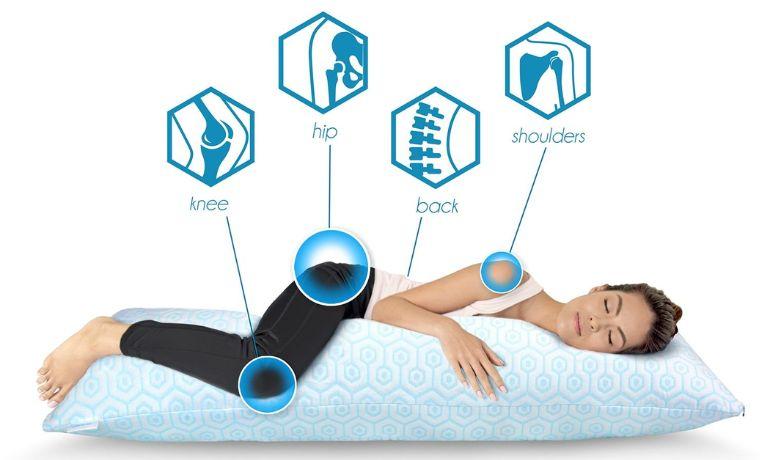Notifications

9 minutes, 38 seconds
-9 Views 0 Comments 0 Likes 0 Reviews

Every morning you wake up with a stiff, aching neck is a reminder that even small things like pillow height matter. Neck pain already affects more than 200 million people worldwide, and that number is projected to keep climbing through 2050.
At the same time, side sleeping is the most popular sleep position, accounting for roughly half of all time spent in bed. Put the two facts together and you get a huge group of sleepers who need very specific support: pillows for side sleepers with neck pain.
Below, you’ll find ten pillow designs that repeatedly score high in clinical trials, lab reviews, and real-world user tests. Think of the list as a menu of proven shapes and fills. Find the style that matches your shoulder width and mattress firmness, and you can finally stop folding a tired, lumpy cushion in half at 3 a.m.
“Adjustable” usually means shredded or layered foam you can add or remove. By matching the loft to the gap between the shoulder and ear, testers at the Sleep Foundation reported a marked drop in muscle activation on the side of the neck. If your mattress is plush, keep more fill; if it’s firm, take some out. Five minutes of tinkering can spare you months of morning aches.
Latex springs back fast and sleeps cooler than traditional memory foam. Shredded versions let you squish, fluff, and reshape the pillow until it feels “just right.” In practical terms, that bounce keeps your head from sinking during the night, key for anyone whose pain flares when the neck tilts down for hours.
These molded pillows look a bit like gentle waves. The higher edge supports the curve of the neck while a shallower center cradles the head. Because the neck stays level with the spine, users often report fewer tension headaches after a week or two of use. Pick a model with an extra-high side rim (about 4–5 inches) if you have broad shoulders.
A soft pouch filled with water sounds gimmicky until you see the data: in a randomized trial, water-based pillows lowered morning pain scores and even improved overall sleep quality compared with both roll and standard pillows. The weight can feel unusual at first, but nothing matches the way the water shifts to maintain constant loft when you roll from one shoulder to the other.
Hybrid pillows layer slow-response foam near the shoulder zone and springy latex or fiber under the head. The result is cradle plus push-back, so your neck is cushioned without letting the skull sink. Zoned hybrids also hold their shape longer than single-density blocks—a big deal if you hate replacing pillows every year.
Overheating makes muscles tense up subconsciously. Gel-infused foams pull heat away, and ventilated cores let air circulate. Test panels at Sleepopolis found gel models stayed up to 4 °C cooler while still meeting perfect-alignment criteria for side sleepers. A cool neck is a relaxed neck, and a relaxed neck feels pain less intensely.
Love hotel-style squish but need real height? A gusset (a fabric wall sewn around the edge) prevents the fill from collapsing. Reviewers frequently call this design the “Goldilocks option” because it balances cloud-like softness with side-sleeper loft. Look for a 2-inch gusset if your shoulders are narrow, 3 inches if they’re broad.
Thousands of polished husks interlock to form a moldable, airy mass. A Korean clinical study in elder-care facilities reported lower neck-and-shoulder pain scores on buckwheat than on latex. The pillow sounds like sand when you move, but nothing beats its ability to lock into a custom shape and stay there until morning.
Side sleepers often tuck a shoulder forward, shortening the trapezius muscles. Crescent pillows carve out space under that shoulder, letting your head settle without tilting. Many users notice that the numb “pins and needles” feeling in the upper arm disappears after switching to a shoulder-cutout design.
Kapok fibers—think ultra-fine cotton—are buoyant, moisture-wicking, and naturally hypoallergenic. Blended with shredded latex or memory-foam chips, kapok pillows hit the medium-firm sweet spot that physical therapists recommend for maintaining a neutral cervical curve. Expect a lighter, airier feel than straight foam and fewer synthetic odors.
How often should I replace my pillow?
Even premium fill breaks down. Plan on 18–24 months for foam or latex and 12–18 months for fiber or down alternatives. Flattened loft means renewed strain on neck muscles.
Can I wash a water-core or buckwheat pillow?
The outer cover usually zips off for machine washing. The water bladder wipes clean with mild soap, and buckwheat hulls should be aired in sunlight rather than soaked. Always follow the maker’s instructions to avoid mold.
What if my pain doesn’t improve?
Persistent neck pain can signal deeper issues such as disc degeneration or nerve impingement. If you’ve fine-tuned loft and tried a high-support pillow for two weeks with no relief, consult a physical therapist or spine specialist. They can screen for underlying problems and recommend targeted exercises.
The search for pillows for side sleepers with neck pain boils down to three essentials: the right loft, steady support, and breathable materials. Start by matching shoulder width to pillow height, choose a fill that holds its shape, and give your body a full week to adapt. Once everything lines up, mornings feel a whole lot better, and that’s the kind of victory that lasts long after the alarm clock rings.
Pillows for Side Sleepers Body Pillow Body Support Pillow Pillow Medical Pillow Neck Pain Support Pillow
